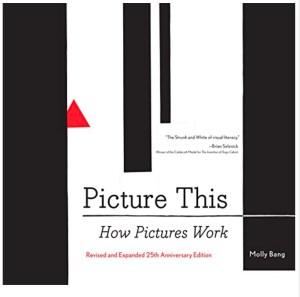
“Details matter. They create depth, and depth creates authenticity.” —Neil Blumenthal
After Five Basic Removals, the ninth tutorial of the Graphic Design Basic Element Series covers Five Depth Clues.
Blumenthal is a transformative lifestyle eyewear brand’s designer, creator, and CEO. Examining his branding, you quickly learn that he understands why details matter in design, even abstract design.
What are Removals in Art & Design?
Transferring the ability to sense dimension and distance in a two-dimensional design requires implementing one of The Five Depth Clues. If a clue isn’t effective in a rendering, the eye will not sense the third dimension, or the intent of the design or illustration will be flat.
The Five Depth Clues are:
- Overlap
- Scale Change
- Foreshortening
- Defusing
- Shadow
Overlap

Most everyone likes to walk in nature. Time spent in a forest offers real-life examples of each of the five depth clues.
Imagine standing on a walking trail in front of a grove of trees. Take note of the circumference of the tree trunks. How does their appearance differ depending on their position, size, and shape?
The partly hidden trees are blocked because the closer trees overlap from your vantage point. In a flattened view, the nearest tree is visually in full view. Therefore, the distant tree is only partly visible. This effect is the first depth clue to note, and its term is called overlap.
Scale Change
Another depth clue is a scale change and is easily identifiable from the same vantage point. In our nature example two trees that appear the same size are really different heights in the forest. The tree positioned at a distance seems much smaller. Scale change is another clue to convince viewers that the artist’s creation illustrates dimension and space.
Foreshortening

While standing on the same path, look back to where the walk began. Notice how the walkway appears more narrow. To garner an authentic sense of perspective, the depth clue of foreshortening is another vital clue.
A snapshot from a mountain vista of a long winding road is another perfect example when the use of foreshortening is noticeable and adds dimension. Another example happens when standing toward the front of a long and narrow building. The height of the back of the building appears to be much shorter.
Defusing
A misty or foggy day is perfect for capturing the effects of defusing. Imagine looking toward a vast field of flowers. The foreground flowers are clearly defined. However, when the viewer looks beyond them and focuses on the flowers in the distance, their shape loses definition. The flowers appear diffused and less vibrant in hue and tone.
Shadow
Light plays an essential role in providing depth clues. For example, an artist or illustrator can use three ways to create cast shadows. Each depth clue description depends on the position of the light and how the opaque surface blocks the light around the object.
Three types of shadows:
- Cast
- Formed
- Foreshortened

Cast
A cast shadow is the most obvious and can vary in size. The length and width are dependent on the light’s angle, and how much of the object’s volume is blocked by the surface. The value will vary along with the tone. There are usually three tonal values, with the darkest seen closest to the object. As the shadow’s distance stretches away from the object, its edges appear softer and less defined.
Formed
A formed shadow has softer and less defined edges than a cast shadow. The light source is closer to an overhead position. This relationship creates a more subtle shaded shape that creates the illusion of volume, mass, and depth. Sometimes the eye will have to squint to notice the shadow mass.
Foreshortened Shadow
Foreshortened shadow depth clues hug the object and mimic and distort its shape depending on the angle of the light. Therefore, a shadow created when using this depth clue has a condensed value and intensity. It is in direct contrast to the object’s angle from the light that it is blocking.
Online Learning Resource: The following link offers a very definitive and helpful resource to learn how to illustrate each of the five different types of shadows that provide clues of depth.
Art Play
By now, your photo collections are providing you with enough depth clue examples. Browse through your art play journal and find each of the five depth clues. Plan time to render clear and straightforward illustrations of each while including examples of the three variations of shadows. Your art journal is steadily becoming an inspirational resource for your ongoing creativity.
A design idea can always be repurposed in another illustration while incorporating different concepts and ideas! Your imagination is limitless.
Supportive Art Resources
Learn about a resource book you might enjoy adding to your art library, click > Key to Painting Light and Shadow by Rachel Rubin Wolf
Downloadable Tutorial Guide
Please feel free to download the 5 Depth Clues tutorial image.
Our next tutorial will describe the Division Principles of Basic Shapes found in design and a downloadable tutorial image.
To follow along, click > Art & Design Tutorial Table of Contents






 A stimulating book on art design to add to your art library is by Ellen Lupton titled:
A stimulating book on art design to add to your art library is by Ellen Lupton titled: 











